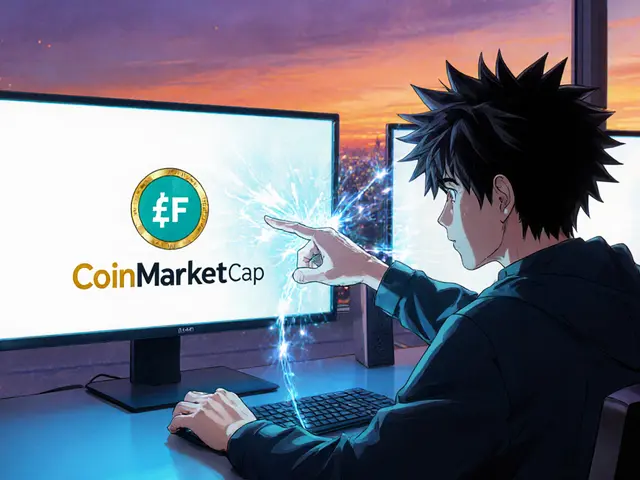Cross-Chain AMM Swap Calculator
Estimate Your Cross-Chain Swap
Calculate estimated costs and slippage for swaps between different blockchain networks using next-generation AMM technology.
Swap Estimate
Based on current AMM liquidity and cross-chain infrastructure
Before 2020, if you wanted to trade crypto on a decentralized exchange, you had to wait for someone to match your buy or sell order. That changed with AMMs - Automated Market Makers. They didn’t need order books. They didn’t need middlemen. They just used math and smart contracts to keep trading alive 24/7. But today’s AMMs aren’t just the same old Uniswap model. They’ve evolved into something far more powerful - and the changes happening right now will reshape how we trade, invest, and even own assets.
Why AMMs Are the Backbone of DeFi
AMMs didn’t just improve decentralized trading. They made it possible. Before AMMs, decentralized exchanges were slow, expensive, and barely usable. Liquidity was thin. Slippage was brutal. If you tried to swap a small token, you’d get crushed by price impact. AMMs solved that by letting anyone deposit tokens into a pool. The algorithm automatically sets prices based on how much of each token is in the pool. No one needs to quote a price. No one needs to be online. It just works.That’s why Uniswap exploded. It wasn’t the first AMM, but it was the first that made it simple. A 50/50 ratio. Two tokens. One pool. Anyone could add liquidity. And suddenly, tiny tokens had trading volume. New projects could launch without venture capital backing. Retail investors got access to assets that used to be locked up in private sales.
But that basic model has limits. When trading volume spikes, fees go up. When you want to trade across chains, it’s a mess. When you try to trade assets that aren’t crypto - like art, music rights, or social influence - the old AMMs don’t know how to price them. That’s where the next generation comes in.
Scalability: Layer 2 and Sharding Are Making AMMs Fast
Ethereum’s congestion killed the dream of cheap, fast trading. Transaction fees hit $50 during peak times. That’s not DeFi. That’s a tax on participation.Next-gen AMMs are fixing this by moving off Ethereum’s main chain. Optimistic Rollups and zk-Rollups are now standard in top DeFi protocols. These Layer 2 solutions bundle hundreds of trades into one transaction on Ethereum, slashing fees by 90% and speeding up confirmations from minutes to seconds. Platforms like Polygon, Arbitrum, and zkSync now host AMMs with near-instant trades and near-zero gas costs.
But Layer 2 isn’t the whole story. Sharding - splitting the blockchain into smaller, parallel chains - is being tested in newer networks like Celestia and EigenLayer. Each shard handles its own trades and liquidity pools. That means the whole system can process thousands of trades at once, not just dozens. The result? AMMs that scale like a bank, not a bottleneck.
Cross-Chain AMMs: Trading Any Asset, Any Chain
You have ETH on Ethereum. You want to trade it for SOL on Solana. Before, you had to bridge your assets - a risky, multi-step process with long waits and potential hacks. Now, next-gen AMMs let you trade directly across chains.Protocols like LayerZero and Axelar have built bridges that aren’t just connectors - they’re liquidity routers. They sync asset balances across chains in real time. So when you swap ETH for SOL on a cross-chain AMM, you’re not moving tokens. You’re swapping liquidity positions between chains through smart contracts. The system ensures the price stays fair, even if one chain is slower.
This isn’t just convenient. It’s revolutionary. It means liquidity isn’t trapped on one chain. A token that’s dead on Ethereum might be booming on Base or Arbitrum. Cross-chain AMMs let that liquidity flow freely. The result? Deeper pools, tighter spreads, and better prices for everyone.

Function Oracle AMMs: Pricing What the Market Feels
Most AMMs use simple formulas - like x * y = k - to set prices. But that only works for stable, predictable assets. What if you’re trading a token tied to a musician’s popularity? Or a meme that’s going viral? Traditional pricing fails.Enter Function Oracle AMMs. This new model doesn’t just look at token balances. It looks at behavior. It tracks how traders interact with the pool - how fast they buy, how much they’re willing to pay extra, what they’re betting on. It captures the "premium" - the invisible value people assign based on hype, fear, or expectation.
Instead of a fixed formula, this AMM uses dynamic wrap and unwrap functions. Each trade adjusts the price based on the last user’s action. Only one trade happens at a time, so the system stays stable. But it reacts instantly to sentiment shifts. If 100 people suddenly rush in to buy a token because of a tweet, the price adjusts in real time - not after a delay, not with a lagging oracle. It’s like having a market maker that reads the room.
This isn’t theory. It’s live on testnets. Early adopters are using it to trade tokens tied to social media trends, influencer endorsements, and even fan engagement metrics. You can now buy a piece of a viral TikTok dance - and sell it when the trend fades.
Specialized AMMs: Curve, Balancer, and the Rise of Niche Pools
Not all AMMs are built the same. The market has split into specialists:- Uniswap still dominates for general token pairs - especially new, volatile ones. Its simplicity keeps it king.
- Curve is the go-to for stablecoins and similar assets. It uses a clever formula that minimizes slippage when swapping USDC for DAI or wETH for stETH. That’s why institutional traders use Curve for large swaps - it’s the quiet professional.
- Balancer lets you create pools with up to eight tokens in any ratio. Want a 70% BTC, 20% ETH, 10% LINK pool? Balancer lets you build it. That’s huge for portfolio managers who want to automate rebalancing without selling assets.
These aren’t just alternatives. They’re different tools for different jobs. And the next wave is even more specialized. We’re seeing AMMs built for NFTs, for options, for yield-bearing assets. There’s now an AMM designed just for trading tokens that pay staking rewards. Another one that adjusts fees based on volatility. The era of one-size-fits-all AMMs is over.
Tokenizing the Intangible: Art, Influence, and IP
What if your favorite podcast host could tokenize their audience’s loyalty? What if a street artist could sell shares of their next mural’s future value? That’s not sci-fi - it’s happening.Next-gen AMMs are now being used to tokenize non-financial assets. Think: social capital, brand influence, creative rights. These aren’t backed by cash flow. They’re backed by perception. And that’s where Function Oracle AMMs shine.
A platform in Berlin is already letting artists mint tokens tied to their upcoming exhibitions. Buyers get voting rights on future projects. The price of the token rises as more people engage with the artist’s content - likes, shares, comments. The AMM tracks that engagement in real time and adjusts the price accordingly.
This isn’t speculation. It’s a new kind of economic incentive. It turns passive fans into stakeholders. It gives creators a way to fund projects without giving up equity. And it opens up a whole new asset class - one that didn’t exist before blockchain.

TradFi Meets DeFi: The Quiet Revolution
Big banks aren’t ignoring DeFi. They’re quietly building on it.JP Morgan, BlackRock, and HSBC are testing AMMs for tokenized bonds, ETFs, and even real estate funds. Why? Because AMMs offer 24/7 liquidity, automated pricing, and lower operational costs. Traditional markets need 8 hours of trading. AMMs never sleep.
ETFs are the bridge. When BlackRock launched its spot Bitcoin ETF, they didn’t just list it on Nasdaq. They also partnered with a DeFi protocol to create a liquidity pool for institutional traders. Now, pension funds can trade Bitcoin exposure on-chain without touching a centralized exchange.
This convergence is accelerating. Derivatives markets are moving on-chain. Options trading on AMMs is growing 300% year-over-year. The old walls between TradFi and DeFi are crumbling - not with a bang, but with a quiet, efficient swap.
What’s Next? AI, Automation, and the End of Manual Market Making
The next leap? AI-driven market making.Today’s best AMMs use heuristics - rule-based systems that react to price swings and volume spikes. But AI models can learn patterns humans miss. They can predict liquidity shortages before they happen. They can adjust fees dynamically based on global news events, social trends, or even weather patterns affecting mining activity.
Some protocols are already testing neural networks that optimize liquidity provision in real time. One system in Singapore reduced slippage by 40% by learning from 10 million past trades. Another uses reinforcement learning to allocate capital across chains based on risk and reward.
This isn’t about replacing humans. It’s about removing the friction. Manual market makers can’t keep up with 24/7 volatility. AI can. And as these systems get smarter, AMMs will become not just trading tools - but intelligent liquidity engines.
Final Thoughts: AMMs Are No Longer Just for Crypto
The AMM of 2025 isn’t just a tool for swapping tokens. It’s a platform for building new economies. It’s how you tokenize your influence. It’s how you trade art without galleries. It’s how banks access crypto liquidity without touching a wallet.The old model - 50/50 pools, static formulas, single-chain limits - is fading. The new model is dynamic, cross-chain, behavior-driven, and AI-enhanced. It’s complex. It’s fast. It’s still evolving.
But one thing’s clear: if you’re not paying attention to AMM innovation, you’re not just missing out on trading. You’re missing the future of how value moves.
What is the difference between old and next-gen AMMs?
Old AMMs, like early Uniswap, used simple math formulas (x*y=k) to price tokens in fixed-ratio pools. They worked well for crypto-to-crypto trades but struggled with volatility, cross-chain swaps, and non-crypto assets. Next-gen AMMs use dynamic pricing, cross-chain liquidity routers, Function Oracle models that track user behavior, and AI to adapt in real time. They support multi-asset pools, tokenized intangibles, and integrate with traditional finance systems.
Can I use next-gen AMMs if I’m not a developer?
Yes. Most next-gen AMMs have user-friendly interfaces on platforms like Uniswap V3, Balancer, or Curve. You can swap tokens, add liquidity, or even create custom pools with just a few clicks. You don’t need to understand smart contracts to use them - just like you don’t need to know how a car engine works to drive. But if you’re providing liquidity or trading complex assets, understanding the risks is essential.
Are Function Oracle AMMs safe?
They’re newer, so they’ve had less real-world testing than Uniswap. But they’re built on audited smart contracts and often run on Layer 2 chains with lower risk. The key is to check if the protocol has been audited by reputable firms like CertiK or Trail of Bits. Also, avoid putting in more than you can afford to lose - especially when trading assets tied to social trends, which can be volatile.
How do cross-chain AMMs prevent price manipulation?
They use decentralized oracles that pull price data from multiple chains simultaneously. If one chain is manipulated, the system compares it to others and ignores outliers. Many also use time-weighted average prices (TWAP) and lock-up periods for large trades to prevent flash loan attacks. The liquidity is pooled across chains, so a spike on one side is balanced by activity on another.
What assets can be tokenized with next-gen AMMs?
Beyond crypto, next-gen AMMs are tokenizing social influence, creative content, fan engagement, intellectual property, and even real-world event outcomes. Examples include tokens tied to a musician’s concert attendance, a YouTuber’s subscriber growth, or a startup’s product launch success. These are called "premium-powered assets" - their value comes from perception and behavior, not cash flow.
Will traditional banks replace AMMs?
No. They’re adopting them. Banks like JP Morgan and BlackRock are using AMMs to provide liquidity for tokenized bonds and ETFs because they’re cheaper, faster, and always open. But they’re not replacing the decentralized nature - they’re plugging into it. AMMs will keep evolving as open protocols, while banks use them as infrastructure. Think of it like using AWS instead of building your own servers.








